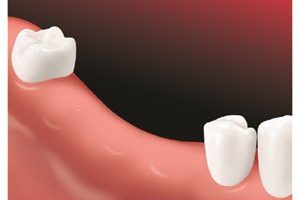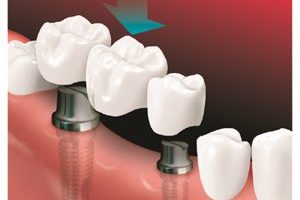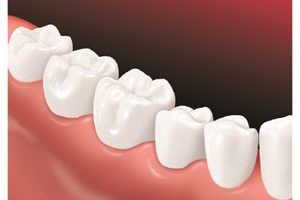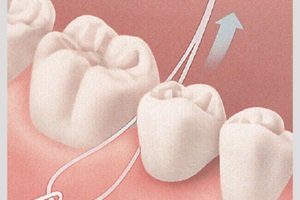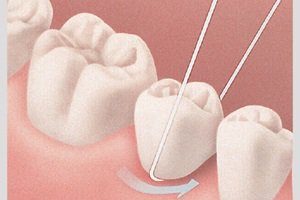- Navigation
- OUR OFFICE
- » MEET OUR DOCTOR
- » MEET OUR STAFF
- » OFFICE TOUR & INFORMATION
- SERVICES
- » FIRST OFFICE VISITS
- » CHILDREN DENTAL CARE
- » PREVENTATIVE CARE
- » COMPOSITE FILLINGS
- » PERIODONTAL
- » ROOT CANAL THERAPY
- » CROWN & BRIDGE
- » EXTRACTIONS
- » DENTURES
- » IMPLANT DENTISTRY
- » WHITENING
- PAYMENTS
- » INSURANCE
- » FINANCING
- » SCHEDULING
- » DENTAL EMERGENCIES
- » SPECIAL OFFERS
- NEW PATIENT
- CONTACT
Your dentist may recommend that you undergo a dental crown procedure for one of several reasons: you have a particularly weak tooth that needs to be held together or requires a bridge; you have an extremely discolored tooth, or you wish to have a crown placed for cosmetic reasons.
What Is A Crown?
A crown is a tooth-shaped cover placed over a tooth that is badly damaged or decayed. Many people call it a cap. Crowns may be placed for several reasons. Usually, because the tooth has been broken or severely damaged by decay. As a result, a filling can't replace enough of the tooth or make the tooth strong enough. A crown may hold together parts of a cracked tooth. It can also be used to hold a bridge in place. Crowns can be used to improve appearance as well. They may be placed to cover misshapen or badly discolored teeth.
What Types of Crowns Are Available?
- Stainless steel crowns are prefabricated crowns that are used on permanent teeth primarily as a temporary measure. The crown protects the tooth or filling while a permanent crown is made from another material.
- Metals used in crowns include alloys that have a high content of gold or platinum, or base-metal alloys (for example, cobalt-chromium and nickel-chromium alloys). Metal crowns withstand biting and chewing forces well and probably last the longest in terms of wear down. Also, metal crowns rarely chip or break. The metallic color is the main drawback. Metal crowns are a good choice for out-of-sight molars.
- Porcelain-fused-to-metal dental crowns can be color-matched to your adjacent teeth (unlike the metallic crowns). However, more wearing to the opposing teeth occurs with this crown type compared with metal or resin crowns. The crown's porcelain portion can also chip or break off. Next to all-ceramic crowns, porcelain-fused-to-metal crowns look most like normal teeth. However, sometimes the metal underlying the crown's porcelain can show through as a dark line, especially at the gum line and even more so if your gums recede. These crowns can be a good choice for front or back teeth as well as long bridges where the metal is needed for strength.
- All-ceramic or all-porcelain dental crowns provide better natural color match than any other crown type and may be more suitable for people with metal allergies. All-ceramic crowns can be used for front and back teeth.
What Steps Are Involved in Preparing a Tooth for a Crown?
Preparing a tooth for a crown usually requires two visits to the dentist -- the first step involves examining and preparing the tooth, the second visit involves the placement of the permanent crown.
First visit: Examining and preparing the tooth
At the first visit in preparation for a crown, your dentist may take a few X-rays to check the roots of the tooth receiving the crown and surrounding bone. If the tooth has extensive decay or if there is a risk of infection or injury to the tooth's pulp, a root canal treatment may first be performed.
Before the process of making a crown begins, your dentist will anesthetize (numb) the tooth and the gum tissue around the tooth. Next, the tooth receiving the crown is filed down along the chewing surface and sides to make room for the crown. The amount removed depends on the type of crown used. If, on the other hand, a large area of the tooth is missing (due to decay or damage), your dentist will use filling material to "build up" the tooth to support the crown.
After reshaping the tooth, your dentist typically will use a paste or putty to make an impression of the tooth to receive the crown. Sometimes, though, impressions are made with a digital scanner. Impressions of the teeth above and below the tooth to receive the dental crown will also be made to make sure that the crown will not affect your bite.
The impressions or scans are sent to a dental lab where the crown will be manufactured. The crown is usually returned to your dentist's office in two to three weeks. If the crown is made of porcelain, your dentist will also select the shade that most closely matches the color of the neighboring teeth. During this first office visit, your dentist will make a temporary crown to cover and protect the prepared tooth while the crown is being made. Temporary crowns usually are made of acrylic and are held in place using a temporary cement.
Second visit: Receiving the permanent dental crown
At the second visit, your dentist will remove the temporary crown and check the fit and color of the permanent crown. If everything is acceptable, a local anesthetic will be used to numb the tooth and the new crown is permanently cemented in place.
What Problems Could Develop With a Dental Crown?
- Discomfort or sensitivity. Your newly crowned tooth may be sensitive immediately after the procedure as the anesthesia begins to wear off. If the tooth that has been crowned still has a nerve in it, you may experience some heat and cold sensitivity. Your dentist may recommend that you brush teeth with toothpaste designed for sensitive teeth. Pain or sensitivity that occurs when you bite down usually means that the crown is too high on the tooth. If this is the case, call your dentist. He or she can easily fix the problem.
- Chipped crown. Crowns made of all-porcelain or porcelain fused to metal can sometimes chip. If the chip is small, a composite resin can be used to repair the chip with the crown remaining in your mouth. This is usually just a temporary fix. If the chipping is extensive, the crown may need to be replaced.
- Loose crown. Sometimes the cement washes out from under the crown. Not only does this allow the crown to become loose, but it also allows bacteria to leak in and cause decay to the tooth that remains. If a crown feels loose, contact your dentist's office.
- Crown falls off. Sometimes crowns fall off. Reasons include decaying of the underlying tooth and loosening of the cementing material used to place the crown. If your crown comes off, clean the crown and the front of the tooth. You can replace the crown temporarily using dental adhesive or temporary tooth cement that is sold in stores for this purpose. Contact your dentist's office immediately. He or she will give you specific instructions on how to care for the tooth and crown for the day or so until you can be seen for an evaluation. Your dentist may be able to re-cement the crown in place; if not, a new crown will need to be made.
- Dark line on crowned tooth next to the gum line. A dark line next to the gum line of your crowned tooth is normal, particularly if you have a porcelain-fused-to-metal crown. This dark line is simply the metal of the crown showing through. While not a problem in itself, the dark line is cosmetically unacceptable and your dentist may have to replace the crown with an all-porcelain or ceramic one.
How Long Do Dental Crowns Last?
On average, dental crowns last between five and 15 years. The life span of a crown depends on the amount of "wear and tear" the crown is exposed to, how well you follow good oral hygiene practices, and your mouth-related habits (you should avoid such habits as grinding or clenching your teeth, chewing ice, biting fingernails, and using your teeth to open packaging).
A dental bridge is a fixed (non-removable) appliance and is an excellent way to replace missing teeth. A bridge is made up of two or more crowns for the teeth on either side of the gap -- these two or more anchoring teeth are called abutment teeth -- and a false tooth/teeth in between.
Reasons for a fixed bridge:
- Fill space of missing teeth.
- Maintain facial shape.
- Prevent remaining teeth from drifting out of position.
- Restore chewing and speaking ability.
- Restore your smile.
- Upgrade from a removable partial denture to a permanent dental appliance.
How a fixed bridge is placed
A fixed bridge means that your dentist uses existing natural teeth on both sides of your missing tooth (or teeth) to help hold your bridge in place. Placing a bridge usually takes more than one dental visit.
- On the first visit, your dentist prepares the teeth on both sides of the gap. The bridge will attach to those teeth.
- Your dentist then makes an impression or an image of your teeth and the space. That information is sent to a dental laboratory where lab technicians follow your dentist’s instructions and make the bridge.
- Your dentist will place a temporary bridge to protect your prepared teeth while you are waiting for the permanent bridge.
- When the permanent bridge is ready, your dentist fits, adjusts and cements the bridge to the prepared teeth. This type of bridge is permanent and cannot be taken out of your mouth without a dentist’s help.
What materials are used in a bridge?
Bridges are made from metal, ceramics, or a combination of the two. Your dentist will talk with you about the materials that are best for you and your mouth.
Caring for your bridge
A bridge can fail if the support teeth or the jawbone is damaged by dental disease. Follow these tips for good oral health:
- Brush your teeth twice a day and floss or use another between-the-teeth cleaner every day. Brushing and cleaning between your teeth helps remove plaque, a sticky film of bacteria that is always forming on the teeth.
- Always clean between your teeth and under the bridge. There are many kinds of flossers, picks, or little brushes. Your dentist will help you decide which is best for your bridge.
- See your dentist regularly for exams and professional cleanings.
- Eat a healthy diet.
- Look for oral care products that display the ADA Seal of Acceptance. These products are scientifically proven to be safe and effective in keeping your mouth healthy.
© 2012-2017 HQNguyen.com, All Rights Reserved. Designed by Web Tech Enterprise, LLC.



